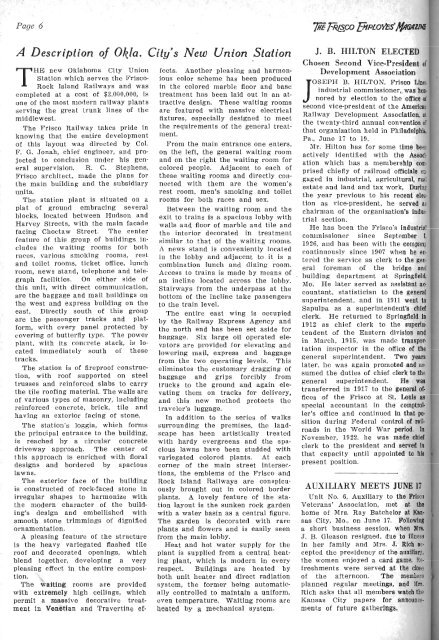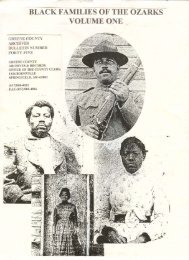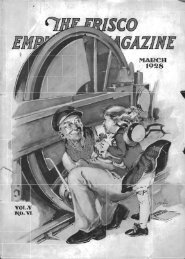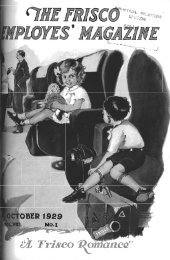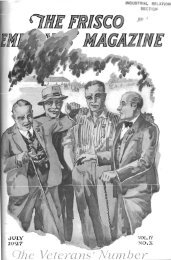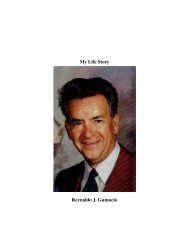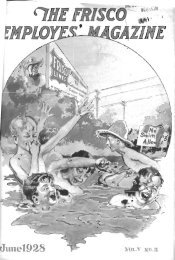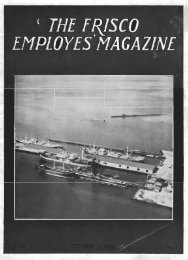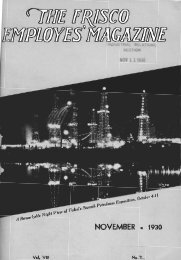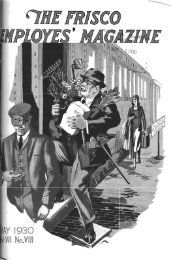Pages 1-76 - Springfield-Greene County Library
Pages 1-76 - Springfield-Greene County Library
Pages 1-76 - Springfield-Greene County Library
You also want an ePaper? Increase the reach of your titles
YUMPU automatically turns print PDFs into web optimized ePapers that Google loves.
A Description of Okla. City's New Union Station<br />
HE new Oklahonla City Union<br />
Station which serves the Frisco-<br />
Rock Island Railways and was<br />
completed at a cost of $2,000,000, is<br />
one of the most modern railway plants<br />
serving the great trunk lines of the<br />
middlewest.<br />
The Frisco Railway takes pride in<br />
knowing that the entire developn~ent<br />
of this layout was directed by Col.<br />
F. G. Jonah, chief engineer, and pro-<br />
jected to conclusion under his gen-<br />
eral supervision. R. C. Steahens,<br />
Frisco architect, made the plans for<br />
the main building and the subsidiary<br />
units.<br />
The station plant is situated on a<br />
plat of ground embracing several<br />
blocks, located between Hudson and<br />
Harvey Streets, with the main facade<br />
facing Choctaw Street. The center<br />
feature of this group of buildings in-<br />
cludes the waiting rooms for both<br />
races, various smoking rooms, rest<br />
and toilet rooms, ticket office, lunch<br />
room, news stand, telephone and tele-<br />
graph facilities. On either side of<br />
this unit, with direct communication,<br />
are the baggage and mail buildings on<br />
the west and express building on the<br />
east. Directly south of this group<br />
are the passenger tracks and plat-<br />
form, with every panel protected by<br />
covering of butterfly type. The power<br />
plant, with its concrete stack, is lo-<br />
cated immediately south of these<br />
tracks.<br />
The station is of fireproof construc-<br />
tion, with roof supported on steel<br />
trusses and reinforced slabs to carry<br />
the tile roofing material. The walls are<br />
of various types of masonry, including<br />
reillforced concrete, brick, tile and<br />
having an exterior facing of stone.<br />
The station's loggia, which forms<br />
the principal entrance to the building,<br />
is reached by a circular concrete<br />
driveway approach. The center of<br />
this approach is enriched with floral<br />
designs and bordered by spacious<br />
lawns.<br />
The exterior face of the building<br />
is constructed of rock-faced stone in<br />
irregular shapes to harn~onize with<br />
the modern character of the huild-<br />
ing's design and embellished with<br />
smooth stone trimmings ot' dignified<br />
ornamentation.<br />
A pleasing feature of the structure<br />
is the heavy variegated flashed tile<br />
roof and decorated openings, which<br />
blend together, developing a very<br />
pleasing effect in the entire composi-<br />
tion.<br />
The waiting rooms are provided<br />
with extremely high ceilings, which<br />
permit a massive decorative treat-<br />
ment in Venetian and Travertine ef-<br />
fects. Another pleasing and harmon-<br />
ious color scheme has been produced<br />
in the colored marble floor and base<br />
treatment has been laid out in an at-<br />
tractive design. These waiting rooms<br />
are featured with massive electrical<br />
fixtures, especially designed to meet<br />
the requirements of the general treat-<br />
ment.<br />
Prom the main entrance one enters,<br />
on the left, the general waiting room<br />
and on the right the waiting room for<br />
colored people. Adjacent to each of<br />
these waiting rooms and directly con-<br />
nected with them are the women's<br />
rest room, men's smoking and toilet<br />
rooms for both races and sex.<br />
Between the waiting room and the<br />
exit to trains is a spacious lobby with<br />
\valls and floor of marble and tile and<br />
the interior decorated in treatment<br />
similar to that of the waiting rooms.<br />
A news stand is conveniently located<br />
ill the lobby and adjacent to it is a<br />
combination lunch and dining room.<br />
Access to trains is made by means of<br />
an illcline located across the lobby.<br />
Stairways from the underpass at the<br />
bottom of the incline take passengers<br />
to the train level.<br />
The entire east wing is occupied<br />
by the Railway Express Agency and<br />
the north end has been set aside for<br />
baggage. Six large oil operated ele-<br />
vators are provided for elevating and<br />
lowering mail, express and baggage<br />
from the two operating levels. This<br />
eliminates the customary dragging of<br />
baggage and grips forcibly from<br />
trucks to the ground and again ele-<br />
vating them on tracks for delivery.<br />
and this new method protects the<br />
traveler's luggage.<br />
In addition to the series of walks<br />
surrounding the premises, the land-<br />
scape has been artistically treated<br />
with hardy evergreens and the spa-<br />
cious lawns have been studded with<br />
variegated colored plants. At each<br />
corner of the main street intersec-<br />
tions, the emblems of the Frisco and<br />
Rock Island Railways are conspicu-<br />
ously brought out in colored border<br />
plants. A lovely feature of the sta-<br />
tion layout is the sunken rock garden<br />
with a water basin as a central figure.<br />
The garden is decorated with rare<br />
plants and flowers and is easily seen<br />
from the main lobby.<br />
Heat and hot water supply for the<br />
plant is supplied from a central heat-<br />
ing plant, which is modern in every<br />
respect. Buildings are heated by<br />
both unit heater and direct radiation<br />
system, the former being automatic-<br />
ally controlled to maintain a uniform,<br />
even temperature. Waiting rooms are<br />
heated by mechanical system.<br />
J. B. HILTON ELECTED<br />
Chosen Second Vice-President of<br />
Development Association<br />
J<br />
OSEPH<br />
B. HILTON, Frisco Llnc<br />
industrial commissioner,. was hon<br />
nored by election to the office oI<br />
second vice-president of the Americaq<br />
Railway Developnlent Association, a'<br />
the twenty-third annual convention cf<br />
that organization held in Philadelphia<br />
Pa.. June 17 to 19.<br />
Mr. Hilton has for some the bt~r<br />
actively identified with the Aasocj<br />
ation which has a membership corn<br />
prised chiefly of railroad official8 en<br />
gaged in industrial, agricultural, real<br />
estate and land and tax work. Durinr<br />
the year previous to his recent elee<br />
tion as vice-president, he served ar<br />
chairman of the organization's Indm<br />
trial section.<br />
He has been the Frisco's lndustri~l<br />
coniinissioner since September l<br />
1026, and has been with the cornpan!<br />
continuously since 1907 when he en<br />
tered the service as clerk to the gen<br />
era1 foreman of the bridge and<br />
building department at <strong>Springfield</strong>.<br />
Mo. He later served as assistant ac.<br />
countant, statistician to the aeneral<br />
superintendent, and in 1911 went to<br />
Sapulpa as a superintendent's chleI<br />
clerk. He returned to <strong>Springfield</strong> in<br />
1912 as chief clerk to the sugerln.<br />
tendent of the Eastern division and<br />
in March, 191.5. was made transpop<br />
latinn inspector in the office of the<br />
general superintendent. Two years<br />
later, he was again promoled and ar;-<br />
sumed the duties of chief clerk to the<br />
general superintendent. He was<br />
transferred In 1917 to the general oh<br />
fices of the Frisco at St. Louis as<br />
special accountant in the comptrol-<br />
ler's office and continued in thst po-<br />
sition during Federal control of rail.<br />
roads in the World War period In<br />
November, 1022, he was made ch~ef<br />
clerk to the president and served in<br />
that capacity until appointed to his 1<br />
present position.<br />
AUXILIARY MEETS JUNE li<br />
Unit No. 6, Auxiliary to the Friacn<br />
Veterans' Association, met rt the<br />
home of Mrs. Ray Batchelor at Kan<br />
sas City, Mo., on June 17. Following<br />
a short business session, when Mrs.<br />
J. B. Gleavon resigned, due to Illn~sv<br />
in her family and Mrs. .J. Rich a(-.<br />
cepted the presidency of the auxiliary,<br />
the women enjoyed a card game. RP.<br />
freshmenls were served at the clost:<br />
of the afternoon. The meinhers<br />
planned regular meetings, and )In.<br />
Rich asks that all members watch the<br />
Kansas City papers for announcc-<br />
ments of future gatherint<br />
t<br />
I


